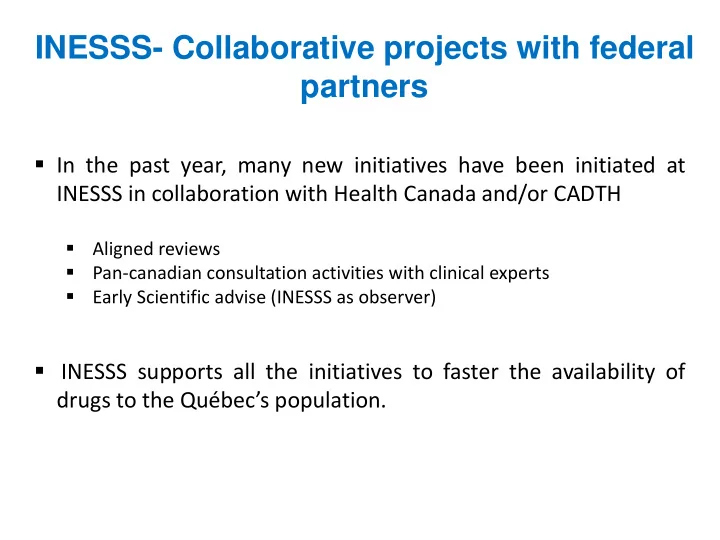

INESSS- Collaborative projects with federal partners In the past year, many new initiatives have been initiated at INESSS in collaboration with Health Canada and/or CADTH Aligned reviews Pan-canadian consultation activities with clinical experts Early Scientific advise (INESSS as observer) INESSS supports all the initiatives to faster the availability of drugs to the Québec’s population.
Quebec’s Life Science Strategy 2017-2027 context • Strategy launched in May 2017 to promote the innovation into the Quebec health and social services system • Impact on the drug assessment processes at INESSS: • Change to a continuous mode of assessment rather than 3 times a year • Implementation of established timelines to perform drugs assessment prescribed as per law • Introduction of drug products assessment process prior to NOC granting by Health Canada • Introduction of the submission fees for manufacturers • As per the Quebec’s Life Science Strategy, INESSS and CADTH recommendations need to be synchronized so that the average difference time between the two organizations is 1 month or less .
INESSS-CADTH launch of the pancanadian consultation with clinical experts • Pilot project launched in September 2018 • Objective: The pilot project provides an opportunity for CADTH and INESSS to establish a panel of Canadian clinical specialists who will provide greater insight into a condition and therapy under review by both organizations • 1 project has been completed: re-evaluation of Spinraza • The relevance and added value of such activity has been conclusive • 2 other projects are currently ongoing
INESSS-CADTH launch of the pancanadian consultation with clinical experts • Particularity • The jointed expert consultation activity happens early in the assessment process. Once this step completed, INESSS & CADTH continue their respective activities. • The final recommendations, coming from 2 separate scientific committees deliberations, can be different despite the commun consultation. 3
INESSS/CADTH/Health Canada initiative Alignment reviews • Launched in June 2018 • INESSS joined the process after completion of the pilot project • Scope: Drug manufacturers now have the option to participate in a formalized, aligned review process between Health Canada, CADTH & INESSS for all submissions that qualify, including new drugs and drugs for new indications. • Benefits: • Reducing delays between Health Canada’s approval and CADTH & INESSS recommendations • Improving communication between the organizations and allowing for real-time discussions that can help reduce duplication
INESSS-CADTH-Health Canada initiative Alignement reviews • Potential risks of the alignement process: • If major delays occur a Health Canada during the regulatory process which will impact the NOC granting date, INESSS can’t complete its evaluation as NOC is required to finalize the recommendation. • Some of the above situations have been observed in the past year. • Additional evaluation activities may be required at INESSS if there is a lately indication modification at Health Canada.
INESSS-CADTH-Health Canada initiative Alignement reviews • 13 files received at INESSS in 2018 in the alignment review • 2 files received until now in 2019 under the alignment review process • 1 file has not been submitted to INESSS yet but submitted at CADTH (exceptional cases to be avoided) • Considering the advantages noted to the process, INESSS wish than more and more files will be submitted under alignment process.
Alignement reviews- recent examples • Case #1 • During the product evaluation cycle, INESSS has taken the opportunity to exchange with Health Canada on the indication to be granted as there were some uncertainties. Without the discussion with Health Canada, INESSS evaluation would have had to be postponed after NOC granting. • Case #2 • The availability of Health Canada reviewers report earlier in time in the alignement process has allowed INESSS to resolve some clarifications points and issue the recommendations in a timely manner rather than extending the timeline.
Alignement reviews- recent examples • Case #3 • Upon reception of a submission at INESSS, a discussion has taken place with Health Canada & CADTH simultaneously to obtain some information on the indication evaluation at Health Canada. The open discussions with the 2 other parties will help INESSS to proceed with file evaluation of a new complex indication.
Real Word Evidence at INESSS • Important & complex topic for HTAs & regulators • RWE is complex and associated with potential bias • INESSS has initiated discussion & activities internally on RWE • INESSS has not yet published orientations on RWE; expected later in 2019 • Notice to industry published in January 2019: • currently possible to submit real word data with drugs evaluation (registry data or observational study) • however real-world evidence approach can’t replace methodologically sound randomized double-blind clinical trials • Recent examples: Spinraza & Galafold recommendations associated with clinical monitoring and potential reassessment. • INESSS is working in collaboration with Health Canada to ensure consistency between upcoming regulations/guidance on RWE
Collaboration to the early scientific advise • Announced in March 2019 • A new collaboration between CADTH, Health Canada and INESSS has been announced: • This new process will allow Health Canada, CADTH and INESSS to collaborate and exchange views while providing their own advice on the manufacturer's drug development plan. • INESSS will initially be participating in an observer role. • Manufacturers will present their information documents to the three organizations. Health Canada and INESSS will participate in the preparatory meetings with CADTH and the experts recruited by CADTH. • Towards the end of the process, Health Canada and CADTH will make interim recommendations to manufacturers in the presence of INESSS observer members. 10
Drug products assessment and foreseen challenges at INESSS • Rare diseases and personalized medicines • Tumor-agnostic drug products & cell therapies combinaisons • Innovative approaches in drug development • Impact of complex therapies on establishments logistic and distribution to patients • Complex evaluations and challenging deliberations • Balance between the individual patient’s interest and collective health need • Transparency, fairness and equity
Recommend
More recommend